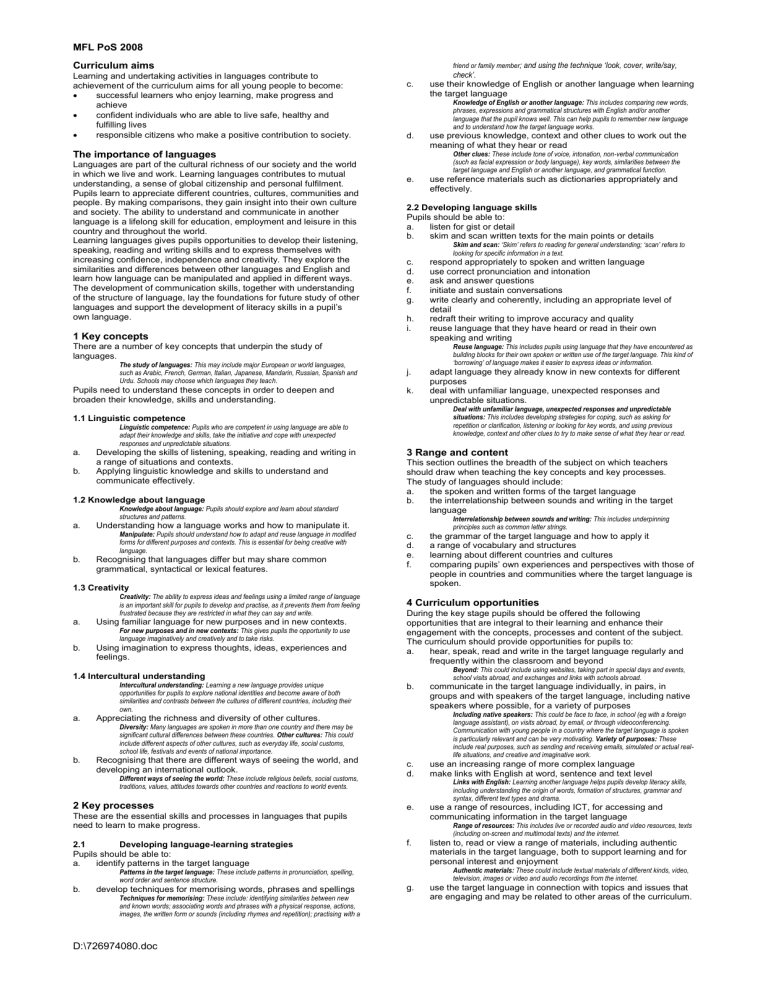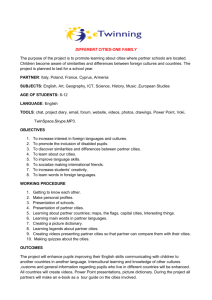Curriculum aims NFL 2008
advertisement

MFL PoS 2008 friend or family member; and using the technique ‘look, cover, write/say, Curriculum aims Learning and undertaking activities in languages contribute to achievement of the curriculum aims for all young people to become: successful learners who enjoy learning, make progress and achieve confident individuals who are able to live safe, healthy and fulfilling lives responsible citizens who make a positive contribution to society. c. Knowledge of English or another language: This includes comparing new words, phrases, expressions and grammatical structures with English and/or another language that the pupil knows well. This can help pupils to remember new language and to understand how the target language works. d. 1 Key concepts e. Pupils need to understand these concepts in order to deepen and broaden their knowledge, skills and understanding. Skim and scan: ‘Skim’ refers to reading for general understanding; ‘scan’ refers to looking for specific information in a text. c. d. e. f. g. h. i. j. k. b. 1.2 Knowledge about language Knowledge about language: Pupils should explore and learn about standard structures and patterns. a. b. 3 Range and content This section outlines the breadth of the subject on which teachers should draw when teaching the key concepts and key processes. The study of languages should include: a. the spoken and written forms of the target language b. the interrelationship between sounds and writing in the target language Interrelationship between sounds and writing: This includes underpinning principles such as common letter strings. Understanding how a language works and how to manipulate it. Manipulate: Pupils should understand how to adapt and reuse language in modified forms for different purposes and contexts. This is essential for being creative with language. Recognising that languages differ but may share common grammatical, syntactical or lexical features. c. d. e. f. 1.3 Creativity Creativity: The ability to express ideas and feelings using a limited range of language is an important skill for pupils to develop and practise, as it prevents them from feeling frustrated because they are restricted in what they can say and write. a. Using familiar language for new purposes and in new contexts. b. Using imagination to express thoughts, ideas, experiences and feelings. For new purposes and in new contexts: This gives pupils the opportunity to use language imaginatively and creatively and to take risks. a. During the key stage pupils should be offered the following opportunities that are integral to their learning and enhance their engagement with the concepts, processes and content of the subject. The curriculum should provide opportunities for pupils to: a. hear, speak, read and write in the target language regularly and frequently within the classroom and beyond Beyond: This could include using websites, taking part in special days and events, school visits abroad, and exchanges and links with schools abroad. b. Recognising that there are different ways of seeing the world, and developing an international outlook. Different ways of seeing the world: These include religious beliefs, social customs, traditions, values, attitudes towards other countries and reactions to world events. 2 Key processes c. d. e. develop techniques for memorising words, phrases and spellings Techniques for memorising: These include: identifying similarities between new and known words; associating words and phrases with a physical response, actions, images, the written form or sounds (including rhymes and repetition); practising with a D:\726974080.doc use a range of resources, including ICT, for accessing and communicating information in the target language Range of resources: This includes live or recorded audio and video resources, texts (including on-screen and multimodal texts) and the internet. f. listen to, read or view a range of materials, including authentic materials in the target language, both to support learning and for personal interest and enjoyment Authentic materials: These could include textual materials of different kinds, video, television, images or video and audio recordings from the internet. Patterns in the target language: These include patterns in pronunciation, spelling, word order and sentence structure. b. use an increasing range of more complex language make links with English at word, sentence and text level Links with English: Learning another language helps pupils develop literacy skills, including understanding the origin of words, formation of structures, grammar and syntax, different text types and drama. These are the essential skills and processes in languages that pupils need to learn to make progress. 2.1 Developing language-learning strategies Pupils should be able to: a. identify patterns in the target language communicate in the target language individually, in pairs, in groups and with speakers of the target language, including native speakers where possible, for a variety of purposes Including native speakers: This could be face to face, in school (eg with a foreign language assistant), on visits abroad, by email, or through videoconferencing. Communication with young people in a country where the target language is spoken is particularly relevant and can be very motivating. Variety of purposes: These include real purposes, such as sending and receiving emails, simulated or actual reallife situations, and creative and imaginative work. Appreciating the richness and diversity of other cultures. Diversity: Many languages are spoken in more than one country and there may be significant cultural differences between these countries. Other cultures: This could include different aspects of other cultures, such as everyday life, social customs, school life, festivals and events of national importance. b. the grammar of the target language and how to apply it a range of vocabulary and structures learning about different countries and cultures comparing pupils’ own experiences and perspectives with those of people in countries and communities where the target language is spoken. 4 Curriculum opportunities 1.4 Intercultural understanding Intercultural understanding: Learning a new language provides unique opportunities for pupils to explore national identities and become aware of both similarities and contrasts between the cultures of different countries, including their own. adapt language they already know in new contexts for different purposes deal with unfamiliar language, unexpected responses and unpredictable situations. Deal with unfamiliar language, unexpected responses and unpredictable situations: This includes developing strategies for coping, such as asking for repetition or clarification, listening or looking for key words, and using previous knowledge, context and other clues to try to make sense of what they hear or read. Linguistic competence: Pupils who are competent in using language are able to adapt their knowledge and skills, take the initiative and cope with unexpected responses and unpredictable situations. Developing the skills of listening, speaking, reading and writing in a range of situations and contexts. Applying linguistic knowledge and skills to understand and communicate effectively. respond appropriately to spoken and written language use correct pronunciation and intonation ask and answer questions initiate and sustain conversations write clearly and coherently, including an appropriate level of detail redraft their writing to improve accuracy and quality reuse language that they have heard or read in their own speaking and writing Reuse language: This includes pupils using language that they have encountered as building blocks for their own spoken or written use of the target language. This kind of ‘borrowing’ of language makes it easier to express ideas or information. 1.1 Linguistic competence a. use reference materials such as dictionaries appropriately and effectively. 2.2 Developing language skills Pupils should be able to: a. listen for gist or detail b. skim and scan written texts for the main points or details There are a number of key concepts that underpin the study of languages. The study of languages: This may include major European or world languages, such as Arabic, French, German, Italian, Japanese, Mandarin, Russian, Spanish and Urdu. Schools may choose which languages they teach. use previous knowledge, context and other clues to work out the meaning of what they hear or read Other clues: These include tone of voice, intonation, non-verbal communication (such as facial expression or body language), key words, similarities between the target language and English or another language, and grammatical function. The importance of languages Languages are part of the cultural richness of our society and the world in which we live and work. Learning languages contributes to mutual understanding, a sense of global citizenship and personal fulfilment. Pupils learn to appreciate different countries, cultures, communities and people. By making comparisons, they gain insight into their own culture and society. The ability to understand and communicate in another language is a lifelong skill for education, employment and leisure in this country and throughout the world. Learning languages gives pupils opportunities to develop their listening, speaking, reading and writing skills and to express themselves with increasing confidence, independence and creativity. They explore the similarities and differences between other languages and English and learn how language can be manipulated and applied in different ways. The development of communication skills, together with understanding of the structure of language, lay the foundations for future study of other languages and support the development of literacy skills in a pupil’s own language. check’. use their knowledge of English or another language when learning the target language g. use the target language in connection with topics and issues that are engaging and may be related to other areas of the curriculum.



![afl_mat[1]](http://s2.studylib.net/store/data/005387843_1-8371eaaba182de7da429cb4369cd28fc-300x300.png)




